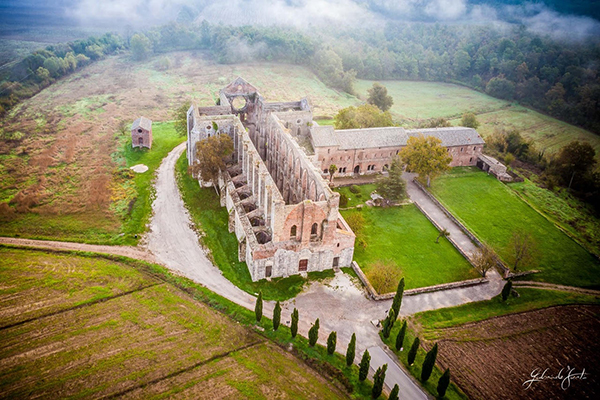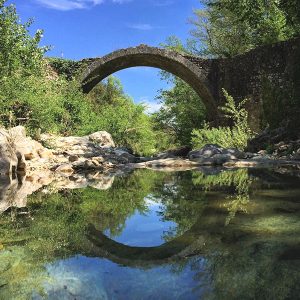Chiusdino e dintorni-english translation

Chiusdino e dintorni
Senza nulla togliere a qualsiasi luogo descritto e che descriveremo per gli itinerari consigliati, Chiusdino e dintorni lasciano i visitatori a bocca aperta. Pare proprio che il tempo si sia fermato in secoli lontani. In provincia di Siena, a soli 48 km da Follonica e circa 1 ora di strada dalla cittadina maremmana, il piccolo borgo che sorge su una delle Colline Metallifere, vanta una storia notevole. La sua origine risale all’anno 572 e furono i Longobardi a fondarla dopo che negli anni 568/569, il popolo di origine germanica conquistò quei territori strappandoli all’Impero Romano d’Oriente. Solo camminando per i vicoli del centro storico ci troviamo in una realtà completamente differente da quella che siamo abituati a vivere tutti i giorni. Volendo programmare un’escursione a Chiusdino e dintorni, è consigliabile prendersi un giorno intero. Con le sue frazioni, ogni comune della Toscana si estende su di un’ampia superficie e le caratteristiche strade panoramiche che si percorrono, talvolta non consentono agevolmente eventuali inversioni di marcia.
Ecco che cosa è possibile visitare nei pressi del comune senese:
L’Abbazia di San Galgano – costruzione Cistercense iniziata poco dopo l’inizio del 1200. Siamo dunque in piena attività Templare di San Bernardo di Chiaravalle. Luogo semplicemente, magico, affascinante e misterioso.
La Cappella di San Galgano a Montesiepi – costruita sul poggio sopra la Chiesa senza né tetto, né vetrate, né pavimento. Fu eretta prima dell’Abbazia tra il 1181 e il 1185. In quel luogo Galgano Guidotti Cavaliere nato a Chiusdino nel 1150, facente parte forse della Tavola Rotonda di Re Artù (Messer Galvano?), si ritirò in preghiera e meditazione il 21/12/1180 conficcando la sua “Spada nella Roccia”. Una copia della parte con l’elsa nella pietra, si può vedere entrando nell’Eremo. Il posto era protetto dai lupi e la storia narra che chi osò dare fuoco e distruggere per invidia il capanno di Galgano venne sbranato dagli stessi “amici” del Santo. Le mani sono state conservate in una teca come ammonimento per i malintenzionati e si possono vedere presso il Fonte Battesimale dove è ammirabile oltre alla vasca ottagonale, anche un autentico capolavoro del pittore senese Ambrogio Lorenzetti (1290-1348).
La Chiesa della Madonna del Buon Consiglio a Frosini – in stile neoclassico. Frazione nella quale è ammirabile dal panorama, il Castello con origini anteriori al sec. XI.
La Casa natale di San Galgano – dove nel 1150 nacque Galgano Guidotti
La Chiesa di San Martino – già presente nel XII sec.
La Chiesa di San Sebastiano – XII sec.
L’ Eremo di Santa Lucia a Rosia – costruito prima del XII sec., in prossimità del Ponte della Pia
che Dante menziona nella Sua Commedia:
“Deh, quando tu sarai tornato al mondo,
e riposato de la lunga via”,
seguitò ‘l terzo spirito al secondo,
“Ricorditi di me, che son la Pia;
Siena mi fé, disfecemi Maremma:
salsi colui che ‘nnanellata pria
disposando m’avea con la sua gemma”.
(Purgatorio V, 130-136)
Il roveto nei dintorni del ponte produce ancora oggi delle buonissime more selvatiche.
La Propositura di San Michele Arcangelo – Santo al quale i Longobardi intitolavano sovente le proprie Chiese principali. Recentemente restaurata (1964), non è più internamente, l’edificio originale.
La Chiesa di Santa Maria Assunta a Ciciano – 1619
La Pieve di Santa Maria a Luriano – già citata da fonti storiche nel 1171
La Chiesa di San Magno a Montalcinello – 1290, purtroppo ha subito danni con i bombardamenti nelle seconda guerra mondiale
Il Santuario della Madonna delle Grazie – 1400 circa
Non mancano nemmeno per questa suggestiva e affascinante escursione i luoghi tipici dove fermarsi per la ristorazione e gustare specialità di produzione locale. Una menzione particolare per il Prosciutto di Chiusdino.
Immagine di copertina: Gabriele Forti
Chiusdino and Surroundings
Without taking anything away from the many places already described or those still to come in these recommended itineraries, Chiusdino and its surroundings leave visitors truly speechless. It feels as though time has stopped centuries ago. Located in the Province of Siena, just 48 km from Follonica and about one hour by car from the coastal town, this small village, perched on one of the Colline Metallifere (Metal-bearing Hills), boasts a remarkable history.
Chiusdino was founded in 572 AD by the Lombards, shortly after their conquest of the region (568/569 AD), which they seized from the Eastern Roman Empire. Simply walking through the alleys of the historic center plunges you into a reality far removed from everyday modern life.
If you plan a day trip to Chiusdino and its surroundings, it’s best to devote a full day. In Tuscany, each municipality includes several hamlets, and the scenic rural roads often don’t allow easy U-turns or changes in route.
Here’s what you can visit in and around this Sienese town:
-
Abbey of San Galgano – A Cistercian abbey whose construction began shortly after 1200. This was the height of the Templar era and the influence of Saint Bernard of Clairvaux. The place is simply magical, fascinating, and shrouded in mystery.
-
Chapel of Montesiepi (San Galgano) – Built on the hill above the roofless, windowless, floorless church. The chapel predates the Abbey itself, constructed between 1181 and 1185. It was here that Galgano Guidotti, a knight born in Chiusdino in 1150, who may have inspired the figure of Sir Galahad of King Arthur’s Round Table, retreated in prayer on December 21, 1180, and drove his sword into the rock. A replica of the sword’s hilt embedded in stone can be seen inside the hermitage.
The site was protected by wolves, and legend has it that those who, out of envy, burned down Galgano’s shelter were torn apart by his wild protectors. The hands of the guilty, preserved as a warning to wrongdoers, are still displayed in a glass case near the baptismal font, alongside an octagonal basin and a masterpiece by the Sienese painter Ambrogio Lorenzetti (1290–1348).
-
Church of Madonna del Buon Consiglio in Frosini – Neoclassical style. From this hamlet, you can also admire the Castle of Frosini, with origins prior to the 11th century.
-
Birthplace of Saint Galgano – The house where Galgano Guidotti was born in 1150.
-
Church of San Martino – Documented since the 12th century.
-
Church of San Sebastiano – Also from the 12th century.
-
Hermitage of Santa Lucia in Rosia – Built before the 12th century, near the Ponte della Pia, the bridge mentioned by Dante Alighieri in his Divine Comedy:
“Ah, when you have returned to the world,
and rested from the long road,”
the third spirit said to the second,
“remember me, who am Pia:
Siena made me, Maremma unmade me:
he knows this, who, with his jewel,
first betrothed me and then abandoned me.”
(Purgatory, Canto V, 130–136)The bramble bushes near the bridge still produce delicious wild blackberries to this day.
-
Church of San Michele Arcangelo – Frequently dedicated to the Archangel by the Lombards, it was restored in 1964, though the interior no longer reflects the original structure.
-
Church of Santa Maria Assunta in Ciciano – Built in 1619.
-
Parish Church of Santa Maria in Luriano – Already mentioned in historical documents from 1171.
-
Church of San Magno in Montalcinello – Built in 1290, it unfortunately suffered damage during World War II.
-
Sanctuary of Madonna delle Grazie – Dates back to around 1400.
This enchanting and unforgettable excursion also offers several typical restaurants and local specialties. A special mention goes to the Chiusdino ham, known for its unique flavor.
Cover image: Gabriele Forti
www.gabrieleforti.it
amici amicizia filastrocche firenze maremma maurizio de cicco poesie poeticando roma siena



